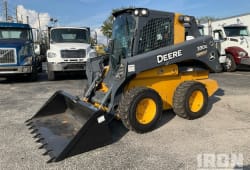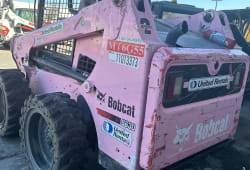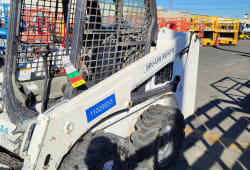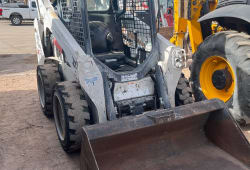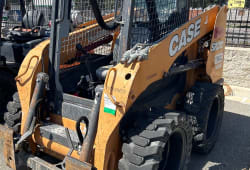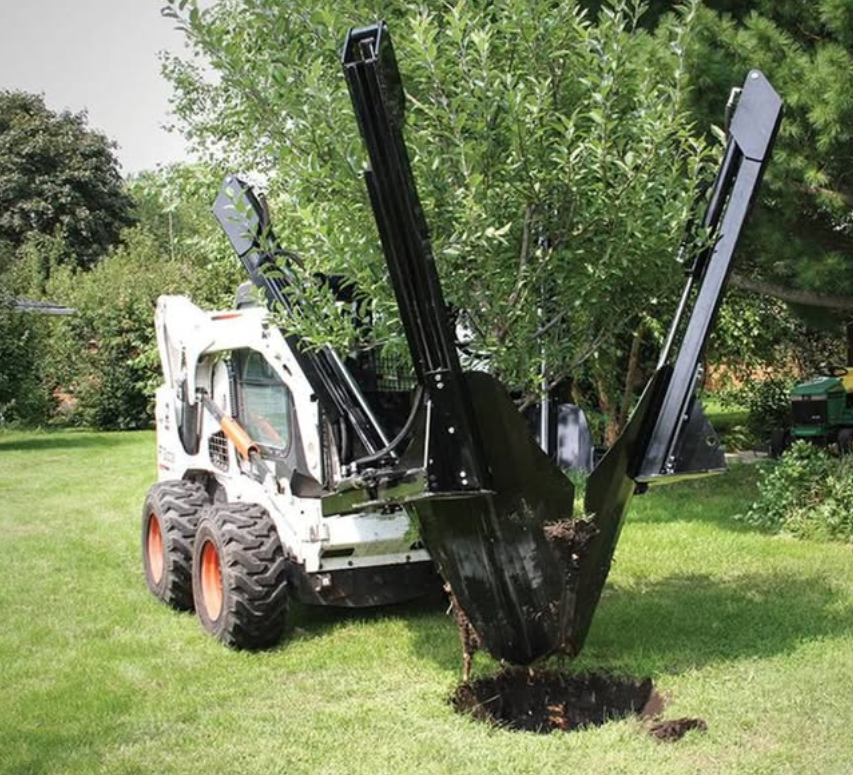Delving Into Skid Steer Varieties: Wheels, Tracks, and More
8 Lectura mínima
)
marzo 4, 2024
Skid steers are highly versatile pieces of equipment widely utilized across various industries for their ability to perform numerous tasks efficiently. From construction and agriculture to landscaping and snow removal, skid steers have become indispensable. This article aims to delve deep into the realm of skid steers, covering their history, types, components, uses, advantages, buying considerations, maintenance tips, and future trends.
What is a Skid Steer?
A skid steer, also known as a skid loader, is a compact, rigid-framed machine equipped with lift arms to which various attachments can be affixed. What sets skid steers apart is their unique ability to perform zero-radius turns, enabling them to maneuver in tight spaces with ease.
History of Skid Steers
:format(webp))
The history of skid steers is a testament to human ingenuity and innovation in the realm of heavy machinery. The journey of these versatile loaders began in the 1950s when Cyril and Louis Keller, two enterprising brothers from Minnesota, embarked on a quest to revolutionize the agricultural industry.
In the rural heartlands of America, the Kellers witnessed firsthand the challenges faced by farmers in efficiently cleaning out their turkey barns. Traditional methods were labor-intensive and time-consuming, prompting the brothers to conceive a novel solution. Drawing inspiration from the concept of crawler tractors, they envisioned a compact, maneuverable machine that could tackle the task with ease.
With relentless determination and a spirit of experimentation, Cyril and Louis set to work in their small workshop, piecing together the components of what would become the world's first skid steer loader. Their design incorporated a rigid frame equipped with lift arms capable of attaching various tools and attachments. The defining feature, however, was the ability of the machine to perform skid steering-a technique where the wheels on one side of the vehicle are powered while the wheels on the opposite side remain stationary, enabling the machine to pivot within its footprint.
In 1957, the Keller brothers unveiled their groundbreaking invention-the Melroe Self-Propelled Loader-a compact, agile machine that would forever change the landscape of agricultural and construction operations. The machine's compact size, versatility, and ease of operation quickly captured the attention of farmers and contractors alike, paving the way for widespread adoption across industries.
As word of the innovative loader spread, demand soared, prompting the formation of Melroe Manufacturing Company to mass-produce the skid steer. Over the decades, advancements in technology and engineering have led to significant improvements in skid steer design, performance, and functionality. Today, skid steers are indispensable tools in a wide range of applications, from construction and landscaping to material handling and snow removal.
The journey of the skid steer from humble beginnings in a Minnesota workshop to global prominence is a testament to human creativity, resourcefulness, and the relentless pursuit of efficiency. Cyril and Louis Keller's pioneering spirit continues to inspire generations of engineers, innovators, and entrepreneurs to push the boundaries of what is possible in the world of heavy machinery.
Types of Skid Steers
Skid steers come in various configurations, each designed to suit specific applications and operating conditions. Understanding the different types of skid steers can help users make informed decisions based on their requirements.
Wheeled Skid Steers
Wheeled skid steers are equipped with rubber tires, making them well-suited for traversing smooth and flat surfaces such as concrete or asphalt. They offer excellent maneuverability and speed, making them ideal for tasks that require frequent relocation or travel over short distances. Wheeled skid steers are commonly used in construction sites, landscaping projects, and agricultural operations where mobility and versatility are paramount. Additionally, their ability to navigate urban environments and confined spaces makes them a preferred choice for indoor applications like warehouse operations and facility maintenance.
Tracked Skid Steers
Tracked skid steers feature rubber or steel tracks instead of wheels, providing superior traction and stability, especially on rough or uneven terrain. These tracks distribute the machine's weight more evenly, reducing ground pressure and minimizing surface damage, making them suitable for use in sensitive environments such as landscaped areas or soft soil conditions. Tracked skid steers excel in demanding applications such as excavation, grading, and forestry work where traction and flotation are critical. Their ability to traverse steep slopes and muddy terrain makes them invaluable for outdoor projects in challenging landscapes. Moreover, tracked skid steers offer enhanced stability when lifting heavy loads, increasing operator confidence and safety.
Mini Skid Steers
Mini skid steers, also known as compact skid loaders or mini loaders, are smaller versions of traditional skid steers designed for light-duty tasks and confined spaces. These compact machines offer maneuverability and versatility similar to their larger counterparts but with reduced dimensions, allowing them to access tight areas and navigate through narrow passages with ease. Mini skid steers are commonly used in residential construction, landscaping, and utility projects where space limitations or weight restrictions necessitate a compact footprint. Despite their smaller size, mini skid steers can accommodate a variety of attachments, enabling operators to tackle a wide range of tasks efficiently.
Vertical Lift Skid Steers
Vertical lift skid steers feature a lift mechanism that provides vertical lift to the lift arms, allowing for increased reach and lifting height compared to radial-lift models. These skid steers are well-suited for applications that require extended reach or the ability to load materials into high-sided trucks or containers. Vertical lift skid steers excel in tasks such as material handling, palletizing, and loading/unloading, where increased lift capacity and reach are essential for optimal performance. Additionally, the vertical lift design enhances visibility for the operator, improving safety and precision during operation.
Radial Lift Skid Steers
Radial lift skid steers employ a lift mechanism that follows an arc-shaped path, providing a combination of lift height and reach ideal for digging and grading tasks. These skid steers offer excellent digging power and breakout force, making them well-suited for earthmoving, excavation, and site preparation applications. Radial lift skid steers are popular choices for construction projects, roadwork, and landscaping tasks that require efficient material handling and precise control. Moreover, their robust construction and durable components ensure reliable performance in demanding environments, enhancing productivity and uptime for operators.
Each type of skid steer offers distinct advantages and capabilities, allowing users to select the most suitable option based on their specific requirements, terrain conditions, and intended applications. Whether it's maneuverability, traction, lifting capacity, or reach, there's a skid steer configuration available to meet the diverse needs of users across various industries.
Components of a Skid Steer
Skid steers consist of several essential components, including the engine, hydraulic system, lift arms, and bucket or attachment. The engine powers the hydraulic system, which in turn controls the movement of the lift arms and attachments, enabling diverse functionalities.
Uses of Skid Steers
Skid steers find application across a spectrum of industries, including but not limited to construction, landscaping, agriculture, and snow removal. Their versatility makes them invaluable for tasks such as digging, lifting, grading, and material handling in diverse environments.
Advantages of Using Skid Steers
The compact size and maneuverability of skid steers offer significant advantages, allowing operators to navigate confined spaces and work in areas inaccessible to larger machinery. Additionally, the availability of a wide range of attachments enhances their versatility and utility.
Factors to Consider When Buying a Skid Steer
:format(webp))
When contemplating the purchase of a skid steer, several factors merit consideration, including size and power, operating capacity, available attachments, and maintenance costs. Choosing the right machine tailored to specific requirements can optimize productivity and efficiency.
Popular Skid Steer Brands
Numerous manufacturers produce skid steers, each offering an array of models with varying features and capabilities. Among the well-known brands in the market are Caterpillar, Bobcat, John Deere, Kubota, and New Holland, renowned for their quality and reliability.
Tips for Operating a Skid Steer Safely
Safe operation of a skid steer necessitates adequate training, adherence to safety protocols, and vigilant attention to operational guidelines. Operators should prioritize personal protective equipment (PPE), conduct pre-operation inspections, and exercise caution during use.
Maintenance Tips for Skid Steers
Regular maintenance is paramount to preserving the optimal performance and longevity of a skid steer. Tasks such as monitoring fluid levels, inspecting tires or tracks, greasing moving parts, and adhering to scheduled service intervals are essential for prolonging the machine's lifespan.
Future Trends in Skid Steer Technology
The evolution of skid steer technology continues to shape the industry, with future trends poised to revolutionize operations. Innovations such as electric-powered models, autonomous functionality, and enhanced connectivity hold promise for streamlining workflow and boosting efficiency.
Conclusion
Skid steers epitomize versatility and efficiency, serving as indispensable assets across diverse industries. Understanding their history, types, components, uses, and maintenance requirements empowers users to harness their full potential and drive productivity.
FAQs
What are the main benefits of using a skid steer?
Skid steers offer unparalleled versatility, maneuverability, and efficiency, making them indispensable for various tasks across industries.
How do I choose the right skid steer for my needs?
Consider factors such as size, power, attachments, and maintenance costs to align the machine with specific requirements and optimize utility.
Can skid steers be used in tight spaces?
Yes, skid steers excel in confined spaces due to their compact size and zero-radius turning capabilities, enabling seamless maneuverability.
Are skid steers easy to maintain?
With proper maintenance and care, skid steers are relatively easy to upkeep, ensuring prolonged performance and reliability.
What are some safety precautions to follow when operating a skid steer?
Operators should undergo comprehensive training, utilize appropriate PPE, conduct pre-operation inspections, and adhere to safety guidelines to mitigate risks and ensure safe operation.

Aaron Kline is the Co-Founder and COO of Boom & Bucket, where he leverages his extensive leadership experience to revolutionize the heavy equipment industry. With a background in building scalable processes and teams from his time as a Naval officer and executive roles in tech, Aaron focuses on introducing cutting-edge technology to construction and agriculture markets. Before Boom & Bucket, he held leadership positions at Skylo and Yard Club (acquired by Caterpillar), and he’s passionate about fostering innovation and driving efficiency in under-digitized industries.

